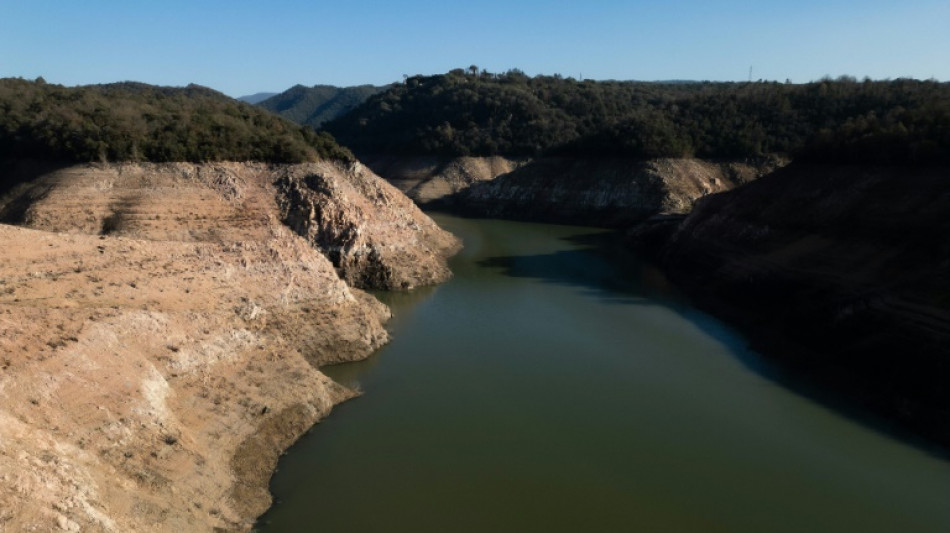
-
 Biden begins historic Amazon trip amid Trump climate fears
Biden begins historic Amazon trip amid Trump climate fears
-
Dozens killed, missing in Israeli strike on devastated north Gaza

-
 Macron defends French farmers in talks with Argentina's Milei
Macron defends French farmers in talks with Argentina's Milei
-
England players to blame for losing streak says captain George

-
 'Emotional' Martin defies Bagnaia to claim first MotoGP world championship
'Emotional' Martin defies Bagnaia to claim first MotoGP world championship
-
Slovakia beat Australia to reach BJK Cup semi-finals

-
 Sluggish Italy fight to narrow win over Georgia
Sluggish Italy fight to narrow win over Georgia
-
India and Nigeria renew ties as Modi visits

-
 Grit and talent, a promise and a dilemma: three things about Jorge Martin
Grit and talent, a promise and a dilemma: three things about Jorge Martin
-
Martin denies Bagnaia to win first MotoGP world championship

-
 Typhoon Man-yi weakens as it crosses Philippines' main island
Typhoon Man-yi weakens as it crosses Philippines' main island
-
Noel wins season-opening slalom in Levi as Hirscher struggles

-
 Tough questions for England as Springboks make it five defeats in a row
Tough questions for England as Springboks make it five defeats in a row
-
Russia pounds Ukraine with 'massive' attack in 'hellish' night

-
 McIlroy clinches Race to Dubai title with DP World Tour Championship win
McIlroy clinches Race to Dubai title with DP World Tour Championship win
-
Glastonbury 2025 tickets sell out in 35 minutes

-
 迪拜棕榈岛索菲特美憬阁酒店: 五星級健康綠洲
迪拜棕榈岛索菲特美憬阁酒店: 五星級健康綠洲
-
The Retreat Palm Dubai MGallery by Sofitel: Пятизвездочный велнес-оазис

-
 New Zealand win revives France on their road to 2027 World Cup
New Zealand win revives France on their road to 2027 World Cup
-
The Retreat Palm Dubai MGallery by Sofitel: A five-star wellness Oasis

-
 Israel hits Gaza and Lebanon in deadly strikes
Israel hits Gaza and Lebanon in deadly strikes
-
Power cuts as Russian missiles pound Ukraine's energy grid

-
 Denmark's Victoria Kjaer Theilvig crowned Miss Universe 2024
Denmark's Victoria Kjaer Theilvig crowned Miss Universe 2024
-
Dutch police use hologram to try and decode sex worker's murder

-
 Israel bombs south Beirut after Hezbollah targets Haifa area
Israel bombs south Beirut after Hezbollah targets Haifa area
-
Biden in historic Amazon trip as Trump return sparks climate fears

-
 India hails 'historic' hypersonic missile test flight
India hails 'historic' hypersonic missile test flight
-
Israel orders Beirut residents to flee after Hezbollah targets Haifa area

-
 Davis, LeBron power Lakers over Pelicans as Celtics win in OT
Davis, LeBron power Lakers over Pelicans as Celtics win in OT
-
Trump and allies return to New York for UFC fights

-
 Hong Kong political freedoms in spotlight during bumper trial week
Hong Kong political freedoms in spotlight during bumper trial week
-
Debt-saddled Laos struggles to tame rampant inflation

-
 Senna, Schumacher... Beganovic? Macau GP showcases future F1 stars
Senna, Schumacher... Beganovic? Macau GP showcases future F1 stars
-
India's vinyl revival finds its groove

-
 G20 tests Brazil's clout in Lula 3.0 era
G20 tests Brazil's clout in Lula 3.0 era
-
Over 20,000 displaced by gang violence in Haiti: UN agency

-
 Famed gymastics coach Bela Karolyi dies
Famed gymastics coach Bela Karolyi dies
-
'Break taboos': Josep Borrell wraps up time as EU's top diplomat

-
 Climate finance can be hard sell, says aide to banks and PMs
Climate finance can be hard sell, says aide to banks and PMs
-
Trump revives 'peace through strength,' but meaning up to debate

-
 New York auction records expected for a Magritte... and a banana
New York auction records expected for a Magritte... and a banana
-
Egypt's middle class cuts costs as IMF-backed reforms take hold

-
 Beirut businesses struggle to stay afloat under Israeli raids
Beirut businesses struggle to stay afloat under Israeli raids
-
Dupont lauds France 'pragmatism' in tight New Zealand win

-
 Swiatek leads Poland into maiden BJK Cup semi-final
Swiatek leads Poland into maiden BJK Cup semi-final
-
Trump taps fracking magnate and climate skeptic as energy chief

-
 West Indies restore pride with high-scoring win over England
West Indies restore pride with high-scoring win over England
-
Hull clings to one-shot lead over Korda, Zhang at LPGA Annika

-
 Xi tells Biden ready for 'smooth transition' to Trump
Xi tells Biden ready for 'smooth transition' to Trump
-
Trump nominates fracking magnate and climate skeptic as energy secretary


Spain sees warmest January on record
Spain has just experienced its warmest January since current records began in 1961, national weather office Aemet said Wednesday, after temperatures neared 30 degrees Celsius (86 degrees Fahrenheit) in some regions.
The average temperature in mainland Spain for January 2024 was 8.4 Celsius, or 2.4 degrees higher than average for the period and 0.4 degrees above the previous record set in 2016, Aemet said.
Temperatures reached or exceeded 20 Celsius last month at nearly 400 meteorological stations, or nearly half the country's total.
Temperatures rose to 29.5C in the eastern region of Valencia, 28.5C in Murcia in the southeast and 27.8C near Malaga in the south -- levels usually seen in June.
The unseasonable winter weather, which drew people to beaches and outdoor cafes across Spain, delayed the start of the ski season and worsened a years-long drought in Catalonia in the northeast and in the southern region of Andalusia.
While January "was a rainy month overall, the distribution of rainfall was very uneven: at least it rained where rainfall was needed the most", Aemet spokesman Ruben del Campo said in a post on X.
Spain had already in 2022 experienced its hottest year since Aemet's annual records began, with an average annual temperature of nearly 15.5 Celsius.
It was the first time that the average yearly temperature surpassed 15 degrees Celsius.
Catalonia's regional government declared last week a drought emergency for Spain's second-largest city of Barcelona and much of the surrounding region, paving the way for tighter water use restrictions after three years without significant rainfall.
It took the measure after water levels at reservoirs in the Mediterranean region fell below 16 percent of full capacity, the benchmark set by the authorities for applying a new round of water-saving measures that will affect around six million people.
Water levels in some reservoirs in Catalonia are so low that old bridges and even a church bell tower have resurfaced in some areas.
Measures to curb water use include a ban on using fresh water for swimming pools, with some exceptions for recognised use in sports. Cars can also now be washed only with recycled water and public gardens irrigated with groundwater.
The measures aim to cut the amount of water used to irrigate crops by 80 percent, doubling the 40 percent reduction introduced last November.
Industries must cut water use by 25 percent, whereas previously it was 15 percent.
- 'Complicated situation' -
Catalonia is facing its worst drought since records began in 1916, with rainfall lower than average in the region for the past three years.
The drought has lasted more than twice as long as the previous dry spell in 2008, the regional government said.
Andalusia is also struggling with severe drought, with regional authorities warning that water-use restrictions will be needed in Seville and Malaga this summer if there is not sufficient rain before then.
Andalusia and Catalonia, Spain's two most populous regions, are both preparing to import fresh water by boat if needed.
"We are facing a very complicated situation," Agriculture Minister Luis Planas told reporters in Madrid after the report of January temperature record.
"Spaniards know very well that climate change is here," he added.
Experts say climate change driven by human activity is boosting the intensity and frequency of extreme weather events such as heatwaves, droughts and wildfires.
T.Wright--AT
